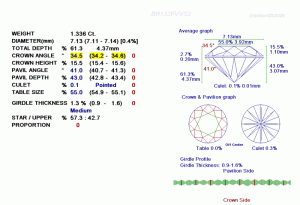gladstone
Rough_Rock
- Joined
- Feb 6, 2006
- Messages
- 67
more info please!!Date: 10/19/2006 9:52:07 PM
Author: Rhino
Average between 40-43 degrees. Once it starts hitting 45 degrees on the steep end a red flag goes up here as well 39 degrees and under on the shallow end. That''s when I want to take a closer look at the stones in question. It is an often neglected measurement that can impact the optics of diamonds that have the most cherry proportion sets.

Any more info and I''d have to have you sign a contract.Date: 10/19/2006 11:20:11 PM
Author: Cehrabehra
more info please!!Date: 10/19/2006 9:52:07 PM
Author: Rhino
Average between 40-43 degrees. Once it starts hitting 45 degrees on the steep end a red flag goes up here as well 39 degrees and under on the shallow end. That''s when I want to take a closer look at the stones in question. It is an often neglected measurement that can impact the optics of diamonds that have the most cherry proportion sets.

Hi Pyramid,
No question is silly.
Good question. Interestingly GIA''s study of this subject found that the shallower angles did not contribute to durability problems. Girdle thickness that is too thin is the culprit according to GIA.Date: 10/20/2006 8:16:10 AM
Author: Pyramid
This is probably a silly question but...
If the 39 degrees is on the shallower angle and the upper girdle facets would ideally be about 40-43 degrees, why are people told that a crown angle of like 29 degrees is too shallow with regard to chipping.
The girdle at the narrowest point between upper girdle facets is below the centre of each upper girdle facet so the crown angle of 29 degrees at the kite facet would be at the widest point on the girdle? I know there is a reason but I just wrongly thought the crown angle being 29 degrees was affecting all along the girdle.
It should but this isn''t always the case. In a classic girdle it would. In fact on a classic girdle the girdle thickness at both the crown mains (your point) and also at the halves should be around the same girdle thickness and as Dave pointed out is also steeper angles than the crown mains. In this attached Sarin note the girdle thickness at the bezels and the halves are very close in thickness to each other. 3.0% and 3.1% with the average girdle thickness in the valley''s being 1.4%. Average upper half angles being around 42 degrees. No red flags in this instance.



Don''t feel bad Pyramid. It''s always ok to ask questions. Questions encourage research and learning is always a good thing.Date: 10/20/2006 8:52:29 AM
Author: Pyramid
Yes Oldminer, that is what I was meaning as they are steeper why does the crown angle which comes down to the wider part of the girdle affect chipping of a girdle. Or is it just that the 39 degrees on upper girdle facets (which Rhino said is too shallow) would be too shallow also?
edited to add: I was just thinking and maybe it is just that the 29 degrees even at the widest part of a ''thin'' girdle would be too shallow. I should think these things out before I post I think

Date: 10/19/2006 8:15:08 PM
Author: gladstone
We all know the ranges for tables, crown and pavillion angles for an ideal diamond. I have not found anywhere the ideal range of [upper girdle facet angles] for a classic girdle?.
Date: 10/19/2006 9:52:07 PM
Author: Rhino
Average between 40-43 degrees. Once it starts hitting 45 degrees on the steep end a red flag goes up here as well 39 degrees and under on the shallow end. That's when I want to take a closer look at the stones in question. It is an often neglected measurement that can impact the optics of diamonds that have the most cherry proportion sets.
